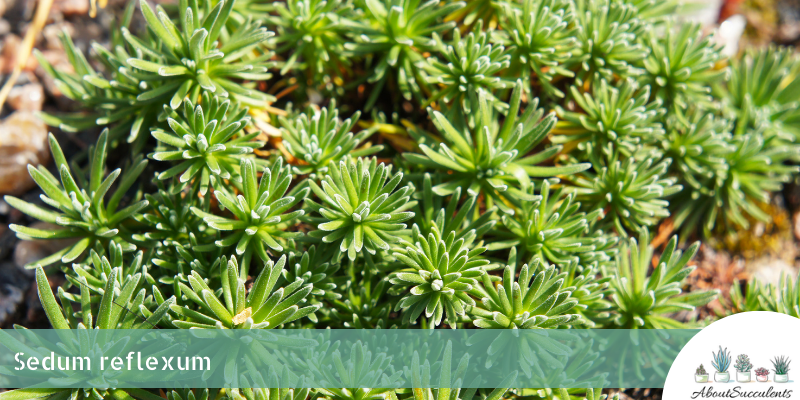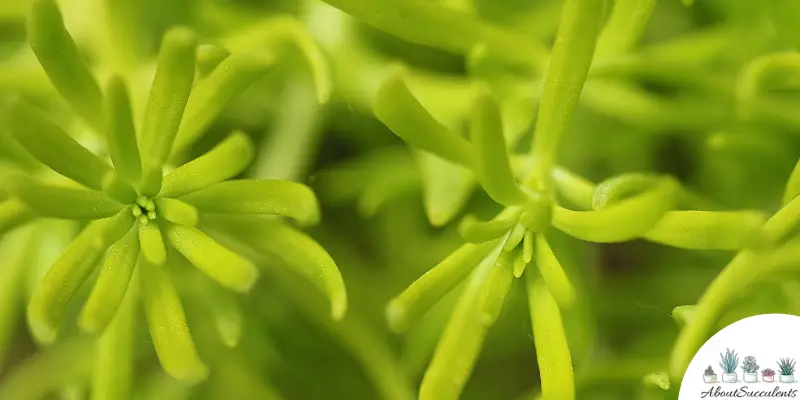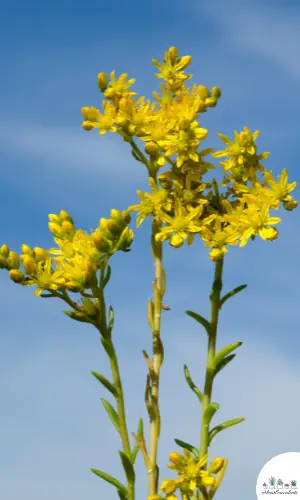
Sedum reflexum is a magnificent succulent that’s readily identifiable by its blue-gray foliage that reaches a height of about 8-inches (20cm). Horticulturists commonly use Sedum reflexum as a ground cover because this variety of succulents grows fast.
The succulent can quickly form a dense blue-green mat with needle-shaped leaves that can reach as far out as 2-feet (60.96cm).
Sedum reflexum’s popular nickname is Blue Spruce Stonecrop but it also has other aliases such as Blue Spruce sedum, Crooked Yellow Stonecrop, Stone Orpine, and Jenny’s Stonecrop.
Blue Spruce Stonecrop’s leaves have the appearance of needles which explains the other nickname, Prick Madam. These majestic leaves will turn into the color pink when temperatures turn frosty.
Watch out for small, star-shaped, and yellow-colored flowers in the summertime. The flowers start out as individuals but grow out and form clusters. You might notice a slight but pleasant scent emitted by Blue Spruce sedum’s blooms.
Don’t be surprised if you see butterflies around Sedum relexum as they’re attracted to the flowers.
Sedum reflexum is a member of the Crassulaceae family and is native to North America and in select dry regions of South America.
General Information
Also known as: Blue Spruce Stonecrop, Prick Madam, Blue Spruce sedum, Crooked Yellow Stonecrop, Stone Orpine, and Jenny’s Stonecrop
Plant Family: Crassulaceae
Origin: North America and a few dry regions in South America
Height: 8-inches (20cm)
Exposure: Partial or full sun for up to 6 hours per day.
Water Needs: Drought-tolerant; check the level of dryness before giving the soil a good soaking.
Soil Type: Sandy or gritty soil mixed with pumice, perlite, and coarse sand for better drainage.
Soil pH: 6.0 to 7.0
How to Grow and Care for Sedum Reflexum

In addition to ground cover, landscape artists also use Sedum reflexum as a trailing succulent by growing them in hanging baskets and containers. But there’s another reason why plant hobbyists love Prick Madam.
This stonecrop from the genus Hylotelephium is easy to grow and care for. Sedum reflexum will do great either as an outdoor or indoor succulent. It’s also a cold-hardy plant and can thrive in Zone 4a temperatures or -30° F (-34.4° C). And as mentioned above, the blue-green leaves turn pink when the cold months set in.
As you will read below, the best way to grow and care for Sedum relexum is to practice neglect.
Sunlight
Succulents need sunlight to produce food and to bring out their colors. Sedum relexum is perfectly fine with partial or direct sunlight.
The important things to remember are that only expose Blue Spruce Stonecrop to morning sunlight. The afternoon sun can be quite harsh and will burn Prick Madam’s leaves. The second thing to remember is the plant should get 6 hours of sunlight every day.
Look for a spot in the garden that meets these 2 requirements. The same applies to an indoor-grown Blue Spruce Sedum. As a hanging succulent, the container should be located near a window that gets partial sunlight for 4 to 6 hours per day.
Watering

Sedum reflexum has the same watering needs of other succulents which is very little. Don’t water the soil when it still contains moisture. To be sure, use the “Soak and Dry” method.
Insert a stick an inch into the topsoil and if it comes out dry, give the soil a thorough soaking.
You might be giving Blue Spruce Sedum water every seven to 10 days in the summertime but it’s always better to check the soil’s level of dryness first. Likewise, expect to water the soil less during winter because low temperatures tend to retain moisture longer.
Pot and Soil
Unglazed ceramic and terracotta should be on the top of your shopping list when you’re thinking about a hanging container for Sedum relexum. These materials support proper soil aeration and allow moisture to escape quickly.
The hanging container must have a drain hole with a mesh cover to let excess water spill out and not lose precious soil.
The best type of soil for Blue Spruce Stonecrop is a gritty and fast-draining variety such as sandy or gravelly soil. Mix in materials like perlite, pumice, and coarse sand to speed up drainage. The ideal soil PH level for Prick Madam is 6.0 to 7.0.
How to Propagate Sedum Reflexum
Sedum reflexum can be propagated using 2 techniques: Stem cuttings and leaves.
Stem Cuttings Method
Step 1: Use a sharpened and sterilized knife to cut away a small section of the stem.
Step 2: Let the stem cuttings rest in a dry area for up to 4 days or until they harden with calluses.
Step 3: Place the stem cuttings on top of sandy soil.
Step 4: Water the soil lightly and position the pot in an area that gets partial sunlight for 4 to 6 hours every day.
Step 5: Once the roots have taken hold, limit the watering schedule only to whenever the soil has gone completely dry.
Leaves Method
Step 1: Perform a smooth clean and pull off a healthy leaf from a stem. Take great care that no part of the leaf is on the stem in order to ensure a successful propagation of Blue Spruce Sedum.
Step 2: Allow the leaves to develop calluses over a period of 2 to 4 days.
Step 3: Place the leaves on sandy soil and lightly spray with water.
Step 4: Position the pot in an area that gets 4 to 6 hours of partial sunlight.
Step 5: If the roots have developed, water the soil only when it’s 100% dry.
Frequently Asked Questions
Is Sedum Reflexum Toxic To Cats and Dogs?
Sedum reflexum isn’t included in the list of plants toxic to cats and dogs that appear on the website of the American Society for the Prevention of Cruelty to Animals (ASPCA).
Why Is My Sedum Reflexum Dying?
If you notice your Sedum reflexum getting weak and on the verge of dying, there could be 2 possible causes of its affliction: Overwatering and Pest Infestation.
Overwatering
When soil stays moist for a long time, it develops a fungal infection. For the succulent, the threat becomes more serious because, under an environment with prolonged moisture, the roots’ cells rupture and begin to rot.
Once the roots have ruptured, the fungi can enter and infect the entire plant. This is why the “soak and dry” method is best for Sedum reflexum because you allow the soil to completely dry out before giving it more water.
You’ll know that Blue Spruce Sedum is infected if you see yellowish, brownish spots on its leaves and stems. Cut these infected sections right away with a sterilized knife. Wipe the knife with 70% isopropyl alcohol after every use.
The next step is to remove the succulent from its soil. Inspect the roots and cut out all of the ones that have turned rotten.
Blue Spruce Stonecrop is in a state of trauma. Give it a chance to recover for a few days before replanting.
Prepare a new pot with fresh sandy soil. Replant Sedum reflexum but don’t water until the soil is 100% dry.
Pest Infestation
Did you notice a honey-like substance dripping from the leaves of Sedum reflexum? These are signs that snails and slugs are making your succulent their home and help themselves to the leaves of Prick Madam.
How about white substances that resemble cotton balls? These are the by-products of sap-drinking mealybugs.
You can remove these pests and their by-products by spraying the plant with diluted neem oil or by wiping the leaves with insecticidal soap or 70% isopropyl alcohol.
Yes, Sedum reflexum produces small, yellow-colored flowers that have a star shape and emit a pleasant but mild fragrance in the summertime.
Last Updated on June 9, 2022 by Sofia Lara